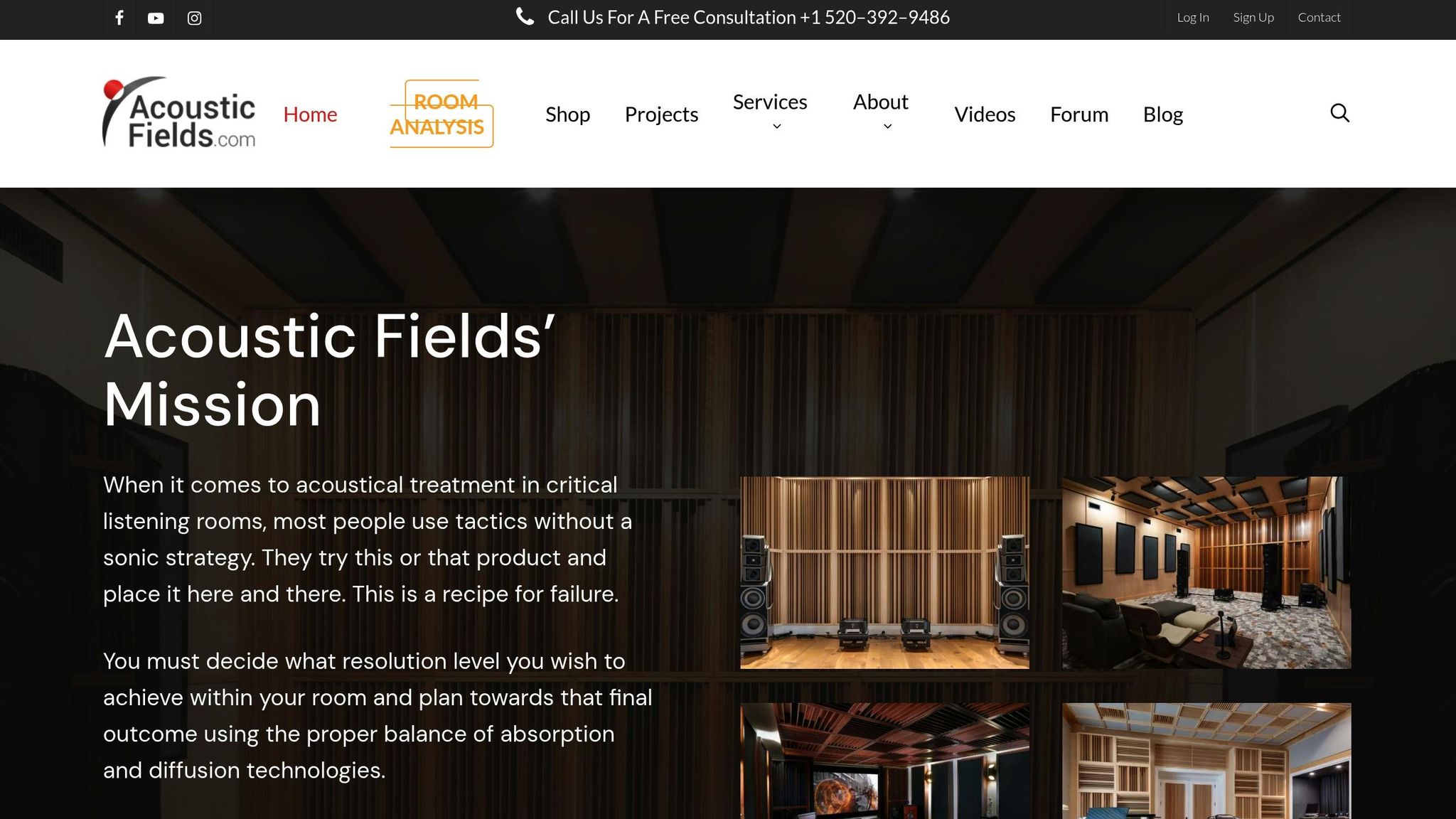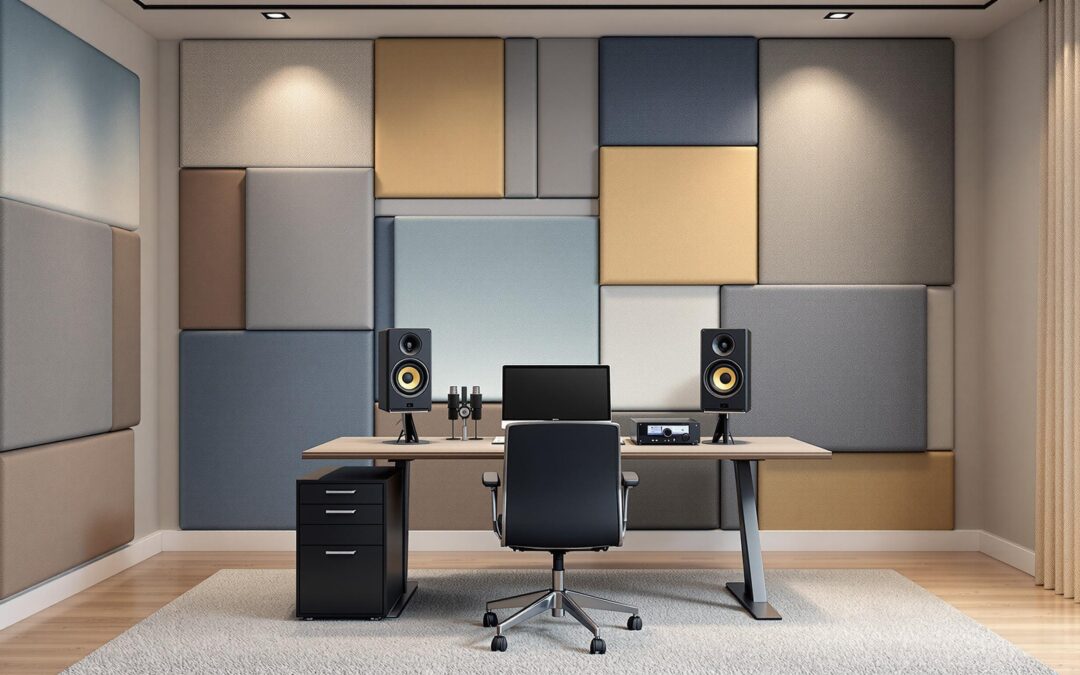Struggling with uneven sound in your space? Standing waves can create acoustic dead zones and frequency imbalances, especially at low frequencies. The solution? Choosing the right materials to absorb sound effectively.
Here’s a quick rundown of the best options for standing wave absorption:
- Glass Mineral Wool: Great for recording studios and cinemas; effective for low to high frequencies depending on density and thickness.
- Fibreglass Sound Panels: Ideal for professional settings like studios and cinemas, providing precise acoustic control.
- Cotton Sound Panels: Eco-friendly and perfect for homes or classrooms; handles mid-range frequencies well.
- Wood Slat Panels: Combines aesthetic appeal with sound absorption, especially for mid to low frequencies.
- Rock Wool Insulation: Durable, recyclable, and strong at reducing standing wave intensity.
Quick Tip: Proper installation and placement are critical for maximum sound absorption. For best results, consult an acoustic expert to tailor materials to your space.
| Material | Best For | Key Features |
|---|---|---|
| Glass Mineral Wool | Studios, cinemas, heritage | Absorbs low to high frequencies |
| Fibreglass Panels | Studios, large venues | Durable, precise sound control |
| Cotton Panels | Homes, classrooms | Eco-friendly, mid-range clarity |
| Wood Slat Panels | Design-focused spaces | Stylish, mid to low-frequency control |
| Rock Wool Insulation | Industrial, multi-purpose | Recyclable, long-lasting |
Takeaway: Understanding your space’s acoustic needs and selecting the right material can dramatically improve sound quality.
What Are Standing Waves In Rooms? – www.AcousticFields.com

1. Glass Mineral Wool
Glass mineral wool is a fibrous material known for its ability to absorb and disperse sound energy.
Its effectiveness depends on two key factors: density and thickness. Higher density works better for mid to high frequencies, while thicker panels are more effective at tackling low, bass-heavy sounds.
This material is widely used in various settings:
- Recording studios: Placed in wall cavities or used as bass traps.
- Cinemas: Installed behind acoustic fabric to enhance sound quality.
- Heritage buildings: Offers reversible installation, preserving the structure.
- Industrial spaces: Used as ceiling baffles to manage noise levels.
Proper installation is critical to ensure long-term acoustic performance.
Glass mineral wool continues to be a go-to solution for sound absorption in commercial, residential, and industrial projects. Up next, let’s explore another option: Fibreglass Sound Panels.
2. Fibreglass Sound Panels
Fibreglass sound panels are a practical solution for managing standing waves in different spaces. Made from dense glass fibres with tiny air pockets, these panels absorb sound waves and convert their energy into heat through friction.
Where They Work Best:
- Cinemas: Minimise sound reflections and standing waves to enhance the clarity of film soundtracks.
- Recording Studios: Installed on walls and ceilings, they provide the precise acoustic control needed for professional recording and mixing.
- Heritage Buildings: Lightweight and easy to install, they improve acoustics without damaging or altering historic architecture.
- Large Indoor Spaces: Ideal for venues like conference halls and performance areas, where sound control is essential.
Fibreglass panels are a reliable choice for improving acoustics across a variety of settings. Up next, we’ll look at Cotton Sound Panels and their specialised acoustic benefits.
3. Cotton Sound Panels
Cotton sound panels are a practical option for managing sound, made from recycled materials like denim and cotton fibres. These panels have tiny air pockets that absorb and break down sound energy, particularly improving clarity in the mid-range frequencies. This makes them a good addition to setups that need more balanced frequency control.
They’re lightweight and easy to install, which makes them suitable for home studios, classrooms, living spaces, and meeting rooms. Adding an air gap during installation can also help improve their ability to handle low frequencies. Plus, you don’t need any special gear to set them up.
With their blend of eco-friendly materials and effective sound absorption, cotton panels work well in a variety of spaces. Up next, we’ll look at Wood Slat Panels for additional sound management options.
sbb-itb-06ab728
4. Wood Slat Panels
Wood slat panels combine wooden strips with an acoustic backing, offering a mix of sound absorption and aesthetic appeal. Their design can be tailored to address specific frequency challenges effectively.
These panels work by trapping sound waves in the gaps between evenly spaced wooden slats and the acoustic backing. By adjusting the spacing and depth of the slats, you can target specific frequency ranges for better absorption.
Typically, wood slat panels are most effective at managing mid to low-frequency standing waves, particularly in the range of 250 Hz to 1,000 Hz. To fine-tune their performance, installers often use 50–100 mm of acoustic backing and maintain an open area ratio of 30% to 40% between the slats.
Factors Affecting Acoustic Performance
Several features influence how well these panels perform:
| Feature | Specification | Impact on Performance |
|---|---|---|
| Slat Spacing | 20–50 mm | Wider gaps improve absorption of higher frequencies |
| Panel Depth | 50–100 mm | Deeper panels enhance control of lower frequencies |
| Air Gap | 25–100 mm | Larger gaps improve bass absorption |
| Wood Type | Hardwood/Softwood | Alters resonant frequencies |
Ideal Applications
Wood slat panels are a great choice for spaces where both sound management and visual appeal are priorities, including:
- Concert halls
- Recording studios
- Conference rooms
- High-end residential areas
To maximise performance, position the panels at first reflection points and maintain at least a 50 mm air gap behind them.
With proper care – regular dusting and occasional wood treatment – these panels can retain their acoustic properties and appearance for 15–20 years.
Up next, we’ll compare different materials to help you make an informed decision.
5. Rock Wool Insulation
Rock wool insulation works well for absorbing standing waves. It’s made by spinning molten rock into fine fibres, creating a complex structure filled with air pockets. These pockets trap and break down sound energy, helping to minimise standing wave intensity. This material pairs well with the other options mentioned and prepares us for a performance comparison in the following section.
Material Performance Comparison
When selecting materials, consider their acoustic properties, environmental impact, and recyclability. Here’s a breakdown of popular materials and their characteristics:
- Glass mineral wool: Known for its high recyclability and significant use of recycled content, this material combines effective acoustic performance with a lower environmental footprint, making it a solid choice for projects balancing performance and eco-consciousness.
- Fibreglass sound panels: While these use less recycled content compared to glass mineral wool, they are durable and well-suited for spaces needing long-lasting acoustic solutions.
- Cotton sound panels: Made from recycled denim, these panels are biodegradable and stand out for their environmental benefits. They are particularly suited for residential installations where sustainability is a key focus.
- Wood slat panels: These offer a natural look alongside good sound management. To ensure sustainable use, sourcing wood from FSC-certified suppliers is essential.
- Rock wool insulation: Made from natural stone, this material is easy to recycle and derived from a stable, natural resource. It’s a strong option for projects prioritising environmental responsibility.
The best choice will depend on the specific needs of your project, local regulations, and sustainability goals.
Summary and Recommendations
To improve sound quality through thoughtful material choices, here’s a quick overview and practical advice:
- Glass mineral wool and rock wool insulation are excellent for high-performance environments.
- Fibreglass sound panels are ideal for commercial and educational settings that demand durability.
- Cotton sound panels work well in homes, offering a mix of acoustic performance and eco-consciousness.
- Wood slat panels combine functionality with style, making them perfect for heritage or design-focused spaces.
Addressing standing wave issues can be tricky, so consulting with an acoustic professional is essential. Proper sound testing helps pinpoint frequency problems, guiding you in selecting and placing materials for the best results.
To make the most of these materials, follow these steps:
- Evaluate the Space: Understand the standing wave patterns unique to the area.
- Choose the Right Materials: Work with experts to match materials to your specific needs.
- Install Carefully: Accurate placement ensures maximum sound absorption.
- Verify Results: Test the space to confirm the desired acoustic improvements.
In short, achieving effective standing wave absorption requires professional insight into material selection and placement. For customised solutions that enhance sound quality, Sound of Silence offers expert guidance tailored to your needs.

